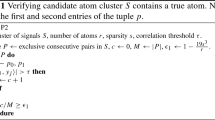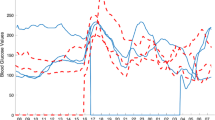Abstract
Estimating overcomplete ICA bases for image windows is a difficult problem. Most algorithms require the estimation of values of the independent components which leads to computationally heavy procedures. Here we first review the existing methods, and then introduce two new algorithms that estimate an approximate overcomplete basis quite fast in a high-dimensional space. The first algorithm is based on the prior assumption that the basis vectors are randomly distributed in the space, and therefore close to orthogonal. The second replaces the conventional orthogonalization procedure by a transformation of the marginal density to gaussian.
Similar content being viewed by others
References
S.-I. Amari, A. Cichocki, and H.H. Yang, “A new learning algorithm for blind source separation,” in Advances in Neural Information Processing Systems 8, MIT Press, 1996, pp. 757–763.
H. Attias, “Independent factor analysis,” Neural Computation, Vol. 11, No. 4, pp. 803–851, 1999.
A.J. Bell and T.J. Sejnowski, “An information-maximization approach to blind separation and blind deconvolution,” Neural Computation, Vol. 7, pp. 1129–1159, 1995.
A.J. Bell and T.J. Sejnowski, “The ‘independent components’ of natural scenes are edge filters,” Vision Research, Vol. 37, pp. 3327–3338, 1997.
J.-F. Cardoso and B. Hvam Laheld, “Equivariant adaptive source separation,” IEEE Trans. on Signal Processing, Vol. 44, No. 12, pp. 3017–3030, 1996.
P. Comon, “Independent component analysis: A new concept?” Signal Processing, Vol. 36, pp. 287–314, 1994.
N. Delfosse and P. Loubaton, “Adaptive blind separation of independent sources: A deflation approach,” Signal Processing, Vol. 45, pp. 59–83, 1995.
J.H. Friedman, “Exploratory projection pursuit,” J. American Statistical Association, Vol. 82, No. 397, pp. 249–266, 1987.
P.J. Huber, “Projection pursuit,” The Annals of Statistics,Vol. 13, No. 2, pp. 435–475, 1985.
A. Hyvärinen, “Independent component analysis in the presence of gaussian noise by maximizing joint likelihood,” Neurocomputing, Vol. 22, pp. 49–67, 1998.
A. Hyvärinen, “Fast and robust fixed-point algorithms for independent component analysis,” IEEE Trans. on Neural Networks, Vol. 10, No. 3, pp. 626–634, 1999.
A. Hyvärinen, “Sparse code shrinkage: Denoising of nongaussian data by maximum likelihood estimation,” Neural computation, Vol. 11, No. 7, pp. 1739–1768, 1999.
A. Hyvärinen, R. Cristescu, and E. Oja, “A fast algorithm for estimating overcomplete ICA bases for image windows,” in Proc. Int. Joint Conf. on Neural Networds, Washington, D.C., 1999, pp. 894–899.
A. Hyvärinen and P.O. Hoyer, “Emergence of phase and shift invariant features by decomposition of natural images into independent feature sub-spaces,” Neural Computation, Vol. 12, No. 7, pp. 1705–1720, 2000.
A. Hyvärinen, P.O. Hoyer, and M. Inki, “Topographic independent component analysis,” Neural Computation, Vol. 13, No. 7, pp. 1527–1558, 2001.
A. Hyvärinen, J. Karhunen, and E. Oja, Independent Component Analysis, Wiley Interscience, 2001.
A. Hyvärinen and E. Oja, “Independent component analysis by general nonlinear Hebbian-like learning rules,” Signal Processing, Vol. 64, No. 3, pp. 301–313, 1998.
A. Hyvärinen and E. Oja, “Independent component analysis: Algorithms and applications,” Neural Networks, Vol. 13, Nos. 4, 5, pp. 411–430, 2000.
M. Inki and A. Hyvärinen, “Two methods for estimating overcomplete independent component basis,” in Proc. Int.Workshop on Independent Component Analysis and Blind Signal Separation (ICA2001), San Diego, California, 2001.
M. Inki and A. Hyvärinen, “Two approaches to estimation of overcomplete independent component bases,” in Proc. Int. Joint Conference on Neural Networks (IJCNN 2002), Honolulu, Hawaii, 2002.
C. Jutten and J. Hérault, “Blind separation of sources, part I: An adaptive algorithm based on neuromimetic architecture,” Signal Processing, Vol. 24, pp. 1–10, 1991.
P. Kanerva, Sparse Distributed Memory, MIT Press, 1998.
J. Karhunen, E. Oja, L Wang, R. Vigärio, and J. Joutsensalo, “A class of neural networks for independent component analysis,” IEEE Trans. on Neural Networks, Vol. 8, No. 3, pp. 486–504, 1997.
S. Kaski, “Dimensionality reduction by random mapping: Fast similarity computation for clustering,” in Proc. Int. Joint Conf. on Neural Networks (IJCNN'98), Anchorage, Alaska, 1998, pp. 413–418.
T. Kohonen, Self-Organizing Maps, Springer, 1995.
H. Lappalainen and A. Honkela, “Bayesian nonlinear independent component analysis by multi-layer perceptrons,” in Advances in Independent Component Analysis, M. Girolami (Ed.), Springer-Verlag: Berlin, 2000, pp. 93–121.
T.-W. Lee, M.S. Lewicki, M. Girolami, and T.J. Sejnowski, “Blind source separation of more sources than mixtures using overcomplete representations,” IEEE Signal Processing Letters, Vol. 4, No. 5, 1999.
M. Lewicki and B. Olshausen, “A probabilistic framework for the adaptation and comparison of image codes,” J. Opt. Soc. Am. A: Optics, Image Science, and Vision, Vol. 16, No. 7, pp. 1587–1601, 1998.
M. Lewicki and T.J. Sejnowski, “Learning overcomplete representations,” Neural Computation, Vol. 12, pp. 337–365, 2000.
E. Moulines, J.-F. Cardoso, and E. Gassiat, “Maximum likelihood for blind separation and deconvolution of noisy signals using mixture models,” in Proc. IEEE Int. Conf. on Acoustics, Speech and Signal Processing (ICASSP'97), Munich, Germany, 1997, pp. 3617–3620.
E. Oja, “The nonlinear PCA learning rule in independent component analysis, Neurocomputing, Vol. 17, No. 1, pp. 25–46, 1997.
B.A. Olshausen and D.J. Field, “Emergence of simple-cell receptive field properties by learning a sparse code for natural images,” Nature, Vol. 381, pp. 607–609, 1996.
B.A. Olshausen and D.J. Field, “Sparse coding with an overcomplete basis set: A strategy employed by V1?” Vision Research, Vol. 37, pp. 3311–3325, 1997.
B.A. Olshausen and K.J. Millman, “Learning sparse codes with a mixture-of-gaussians prior,” in Advances in Neural Information Processing Systems, Vol. 12, MIT Press, 2000, pp. 841–847.
P. Pajunen, “Blind separation of binary sources with less sensors than sources,” in Proc. Int. Conf. on Neural Networks, Houston, Texas, 1997.
A. Pece, “The problem of sparse image coding,” Journal of Mathematical Imaging and Vision, 2002. In this issue.
E.P. Simoncelli, W.T. Freeman, E.H. Adelson, and D.J. Heeger, “Shiftable multiscale transforms,” IEEE Transactions on Information Theory, Vol. 38, pp. 587–607, 1992.
E.P. Simoncelli and O. Schwartz, “Modeling surround suppression in V1 neurons with a statistically-derived normalization model,” in Advances in Neural Information Processing Systems 11, MIT Press, 1999, pp. 153–159.
C. Zetzsche and G. Krieger, “Nonlinear neurons and high-order statistics: Newapproaches to human vision and electronic image processing,” in Human Vision and Electronic Imaging IV (Proc. SPIE Vol. 3644), B. Rogowitz and T.V. Pappas (Eds.), SPIE, 1999, pp. 2–33.
Author information
Authors and Affiliations
Rights and permissions
About this article
Cite this article
Hyvärinen, A., Inki, M. Estimating Overcomplete Independent Component Bases for Image Windows. Journal of Mathematical Imaging and Vision 17, 139–152 (2002). https://doi.org/10.1023/A:1020633503820
Issue Date:
DOI: https://doi.org/10.1023/A:1020633503820




